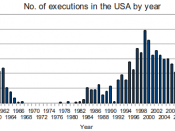From 1967 until 1972, the United States Supreme Court debated on whether or not capital punishment is constitutional. On June 29, 1972, the U.S. Supreme Court ruled that the death penalty is unconstitutional because in some cases it can go against the Eighth Amendment. The Eighth Amendment protects citizens from "cruel and unusual punishment". For nine years, from 1967 until 1976, capital punishment was in a state of national moratorium. This means the states stopped all executions. In July of 1976, the Court upheld the death penalty as a reasonable punishment for some crimes.
Presently, the death penalty is legal in all but 12 states. From January 1977 through April 2001, 710 executions were carried out in the United States. 545 were by lethal injection, 149 by electrocution, 11 by gas chamber, three by hanging, and two by firing squads. Although more than 105 nations worldwide have abolished the death penalty, the United States, along with countries notorious for abusing human rights, are major advocators and users of capital punishment.
Of the countries that still support the death penalty, only five use lethal injection, seventy-three use firing squads, 58 hang condemned criminals, six stone them to death, and three still use beheading.
In this century, at least 400 people have been convicted of capital crimes they did not commit. Of those 400, 23 were executed. The United States has proven that is it unable to prevent accidental executions of innocent citizens. The amount of innocent lives lost may seem minuscule, but what if one of those lives was that of your own child? Or maybe that of a friend, or another loved one. What if it was your own life that was wrongfully sentenced to die?
Every year, about 22,000 homicides are committed. Of those 22,000 killings, only an...



Capital Punishment
What if the person murdered were you child, or a loved one, or a close friend? What would you do if you knew the murderer was still alive...and able to possibly go on parrol? These are questions to make you think about the other side of capital punishment. Of the 23 families affected because of it, don't you think the guilty put to death should be of more importance according to the number? The murdered people's family should be of more importance, because there are more of them. What if you had a little 5 year old daughter or son kidnapped and murdered? Would you want the kidnapper and murderer to live? They sure didn't obey human rights. THEY DIDN'T CARE! Why is it that you human rights people care for the murderer and not the murdered?
4 out of 4 people found this comment useful.